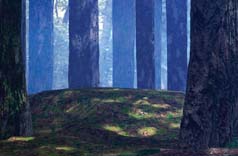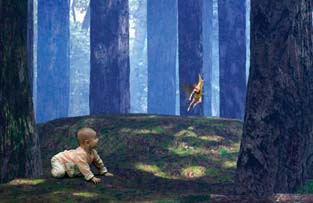Hack 67. Create a Surreal Scene
| < Day Day Up > |
|
Using a layering technique, place people "inside" a surreal environment, such as a dream sequence. There are limited genres and scenarios in which, as a movie producer, you can let your imagination run wild. One scenario in which this occurs is when you are attempting to convey a dream. Well, if you can alter reality in a dream, why not alter it in an unusual fashion? You can place your characters in a watercolor meadow, a crayon-colored office, or, if you're artistically challenged, a computer-rendered planet surface.
6.8.1. Creating Your Foreground and BackgroundYou will be creating a complete environment where your characters will interact. In order to achieve this, you will need to create both a foreground and a background image to be layered in front of and behind your characters, respectively. Your foreground image should consist of props, such as desks, or cars. These props will be used to provide an illusion of depth. When choosing a medium on which to create your foreground, choose a color you do not plan on using in your foreground artwork. This is because you will be transferring your artwork and adding it to your scene. In order to do so, you need to key out the color of the medium you have chosen. Otherwise, parts of your image will be made transparent along with your background. For example, if you have selected to create your foreground artwork on a sheet of green paperboard, you should not use any green in your actual artwork.
Your background image should cover the entire surface of whatever medium you are using (or not, if that's your artistic vision). The background of your sequence should also provide some type of perspective, including a horizon line. 6.8.1.1. Using art supplies to make your images.If you are more artistic, paint, color, and draw your way to the environment of your dreams. Keep in mind that when you have finished, you will need to import your work into your computer. Therefore, you should create something that can be easily transferred to your computer. If you have a scanner, scan your image at a high-resolution setting. Even though you will be using only a 720 x 480 image (720 x 576 for PAL), it is always better to have more detail available should you need to manipulate the image. If you do not have a scanner available, you can just as easily use your video camera to record your artwork. When using a video camera, make sure you both light the image appropriately and keep it framed. A good method is to capture the image using a tripod to stabilize your camera. 6.8.1.2. Using your computer to make your images.If you fall into the artistically challenged category, as I do, you can create your background using your computer. One program that is exceptionally adept at creating landscapes and environments is DAZ|Studio (http://www.daz3d.com/studio/; free). DAZ|Studio is an easy to use program that focuses on creating three-dimensional landscapes and comes with pre-built backgrounds and props. It is available for both Windows and Macintosh. Figure 6-22 shows a shot from the Fairy Forest setting within DAZ|Studio. Figure 6-22. The Fairy Forest: a built-in scene If you find you just can't create a background you are happy with, take a peek at the prebuilt offerings at DAZ. Many are reasonably priced and are quite impressive. I feel they offer a lot of production value, when you have the chance to use them.
6.8.2. Shooting Your SceneIn order to place your characters in the environment you have created, you will need to record them in front of a green screen [Hack #70]. Make sure your green screen and your characters are well lit. If you have the time while shooting your scene and have a semiportable editing system, capture some green screen footage and test how well it works with your background. By doing so, you will be able to correct any problems before they are recorded. 6.8.3. Compositing Your SceneOnce you have designed and imported your foreground and background images, and have digitized your green screen footage, you will have all of the elements necessary to composite your layers together and create your scene. One the bottom layer of your timeline, place your background footage. On the next layer up, place the footage you shot in front of a green screen. Finally, place your foreground footage on the third layer. The first step you will want to take is to key your foreground. This process is the same as keying out a green screen, with the difference being how you accomplish the key:
After keying your foreground, key your green screen footage [Hack #70] so that it, too, becomes a part of the scene. After accomplishing both the foreground and green screen keys, you will need to finesse your scene by moving the center of your layers around, so that your image composition is how you want it. When you have successfully keyed the green screen and your foreground footage, and placed everything to your liking, the scene will look as if it was all recorded at the same time. You will probably have to make minor adjustments to the "look" of your scene before rendering your scene and considering it complete. Figure 6-23 shows a completed scene. Figure 6-23. A composited scene consisting of three layers When all of your effects have been placed and configured, and your scene is complete, render, sit back, and enjoy your dream. 6.8.4. Hacking the HackYou can really be creative with this approach to creating a scene. For your background, create a long image horizontally. When you shoot your characters, have them walk from one side of the screen to the other. Then, when you composite the images together, add some movement to the background by changing its position relative to your characters. Create multiple layers for use in your foreground. If you have more than one person in your scene, you can then place them at different layers within the scene along with foreground items between them. Add a shadow to the props and your characters [Hack #71] for more depth. You can also apply different video effects to individual layers or your entire scene. Manipulating the saturation, brightness, and hue will help bring out the surreal nature of the scene you create. You can also resize your foreground props or even your characters! Don't forget, it's your world; your viewers are just visiting. |
| < Day Day Up > |
EAN: 2147483647
Pages: 158


 Effects Palette
Effects Palette